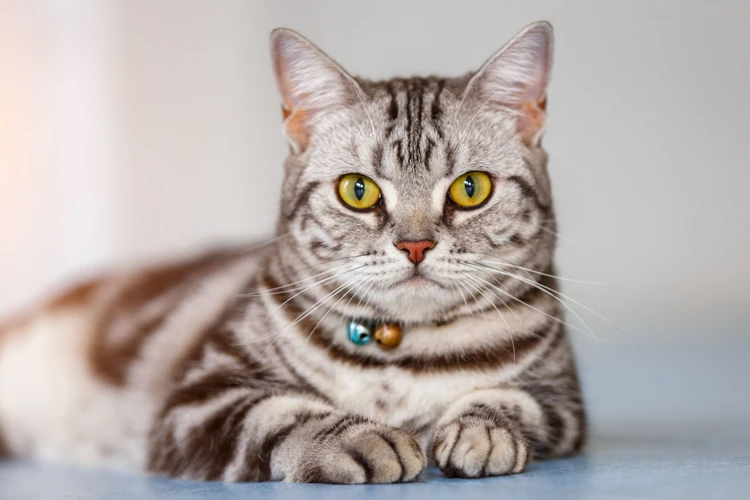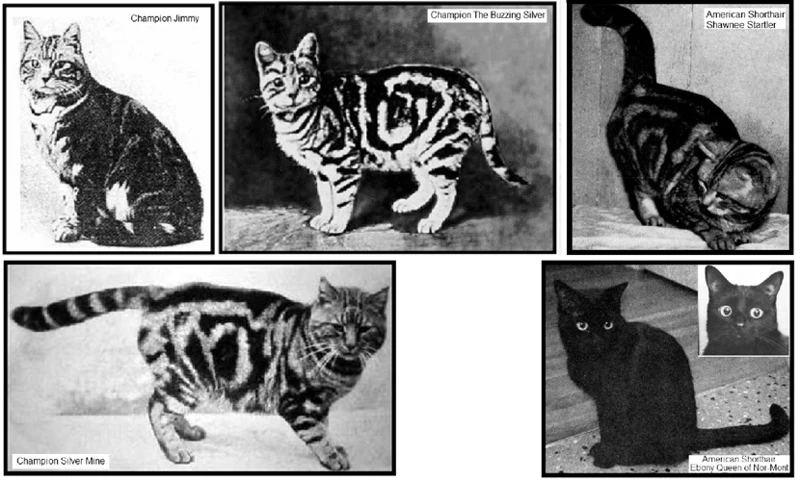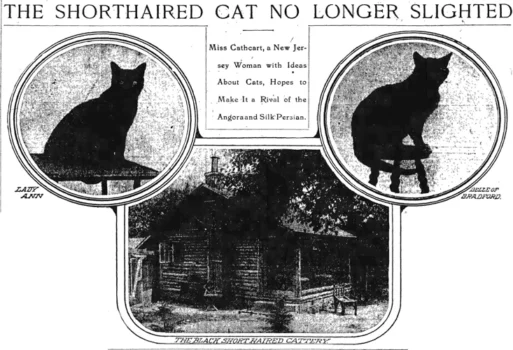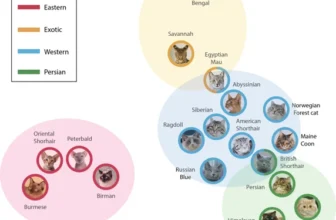American Shorthair cats have long been a beloved breed among cat enthusiasts, known for their expressive eyes, sturdy build, and affectionate personalities. But how did this breed come to be, and what role has selective breeding played in their development? In this article, we’ll delve into the fascinating history of American Shorthair cats, from their ancestral roots to their modern-day popularity. We’ll explore the process of selective breeding, its goals and methods, and how it has shaped the evolution of this beloved feline breed. So, pull up a chair, grab your favorite furry friend, and let’s dive into the world of American Shorthair cat breed evolution.
The Origins of American Shorthair Cats

It’s fascinating to learn about the origins of the American Shorthair cat breed and how they came to be the lovable pets that we know today. Understanding their history can give us insight into the traits and characteristics that make them unique among other feline breeds. Let’s take a closer look at the historical role they played in American history and their ancestral roots that still influence them today. To learn more about their evolution and how selective breeding has shaped the American Shorthair breed, explore the links below.
Their Historical Role in American History
American Shorthair cats are a beloved breed that has a rich history in American society. Their roles in shaping American history and culture are significant as they have been present in the country for over 400 years.
Colonial Era: During the colonial era, American Shorthair cats were brought to the United States on ships to help control rodent populations. They quickly adapted to their new surroundings and became an important part of everyday life. Their presence in homes and barns were highly valued as they kept the rodent population under control, thus protecting the crops and goods.
Civil War Era: American Shorthair cats served a significant role during the Civil War. They were used to protect the food supplies of the Union Army camps from rodents and were also used as messengers. Their ability to navigate through the terrain quickly made them ideal for delivering messages.
Post-War Era: After the war, American Shorthair cats became popular pets. Their personalities and friendly dispositions made them ideal for families. They became a symbol of American life and culture, particularly with their presence in Hollywood movies.
The American Shorthair breed has played a significant role in American society and culture, from protecting homes and crops to serving as important elements of the film industry. As they adapted to their new environments and roles, the breed evolved through selective breeding and genetic diversity, which shaped their physical characteristics and personality traits. To learn more about the evolution of American Shorthair cats, check out our article “American Shorthair Breed Evolution.”
Their Ancestral Roots
The American Shorthair cats have a long and complex ancestral history that dates back to the early days of human civilization. These cats are believed to be the descendants of domesticated cats brought to North America by European settlers during the 1600s.
Research has shown that the genetic ancestry of American Shorthair cats is quite diverse, with influence from various cat breeds such as the British Shorthair, Siamese, and Persian cats. The domestication of cats also played a significant role in shaping the evolution of American Shorthair cats. They were originally kept as companion animals to help control rodent populations on farms and in homes.
Interestingly, the influence of European Shorthair cats cannot be ignored when discussing the ancestral roots of American Shorthair cats. European Shorthair cats played a significant role in the initial breeding programs of American Shorthair cats and influenced their overall physical appearance and personality traits.
Some experts also believe that the genetic diversity of American Shorthair cats helped the breed to evolve and thrive over time. This diversity allowed them to adapt to different environments and overcome environmental challenges such as disease outbreaks and climate changes.
Understanding the genetic ancestry of American Shorthair cats is crucial in comprehending their evolution through selective breeding over the years. To learn more about the genetic diversity and history of American Shorthair cats, you can click on the link /genetic-diversity-american-shorthair-cats/.
The Basics of Selective Breeding

Amidst the wide variety of feline breeds across the world, one factor that has significantly impacted their evolution is selective breeding. Selective breeding is the practice of mating specific cats with particular traits to produce offspring with desirable characteristics. This has played a significant role in shaping the appearance, temperament, and health of the American Shorthair breed over the years. In this section, we will delve into the basics of selective breeding, including what it entails and the goals it aims to achieve. We will also touch on some of the essential factors that have influenced the breeding of American Shorthair cats throughout their evolution. For more information on the genetic ancestry of American Shorthair cats, kindly check out our previous article.
What Selective Breeding Entails
Selective breeding is a process that involves carefully mating cats with desired traits to produce litters with the same characteristics. This process entails several crucial steps, including selecting the parent cats, monitoring the mating process, and selecting the best offspring to continue the breeding process. With careful consideration, selective breeding can produce cats with desirable physical and behavioral traits, as well as good health.
One of the most important steps in selective breeding is identifying the traits to be targeted in the breeding program. Breeders may aim to produce cats with particular coat colors, patterns, or textures, or to enhance specific personality traits and temperaments. Breeders often keep detailed records of breeding pairs and their offspring to monitor the effectiveness of these breeding programs.
Another important aspect of selective breeding is ensuring the health of the breeding cats and their offspring. Breeders may perform genetic testing to identify potential health issues and avoid breeding cats with genetic disorders. They may also monitor the health of the cats throughout their lives to ensure that they remain healthy and free from disease.
Selective breeding is a complex and highly involved process that requires a great deal of knowledge and expertise. Responsible breeders take great care to ensure that their breeding programs are ethical and that their cats are healthy and well-cared-for. This approach helps to ensure that American Shorthair cats and other breeds of cats continue to evolve in positive ways.
The Goals of Selective Breeding
Selective breeding refers to the deliberate intervention in the breeding process to select for certain desirable characteristics. The goals of selective breeding vary depending on the breed, but in general, breeders aim to produce cats with specific physical and behavioral traits. Here are some of the main goals of selective breeding for American Shorthair cats:
- Improving Health: One of the primary goals of selective breeding is to produce cats that are healthy and free from genetic defects. Breeders carefully screen cats for hereditary diseases and conditions, and select only the healthiest individuals for breeding.
- Enhancing Appearance: Another important goal of selective breeding is to produce cats that meet breed standards for appearance. Breeders strive to create cats with the desired coat color and pattern, eye color, and body shape. For American Shorthair cats, the breed standard emphasizes a muscular, sturdy build and a short, dense coat in a variety of colors.
- Developing Specific Behaviors: Selective breeding can also be used to produce cats with specific behavioral traits. For example, breeders may aim to create cats that are more outgoing and social, or cats that are better suited to living in multi-pet households. However, it’s important to note that behavior is influenced by a variety of factors, including genetics, environment, and early socialization.
- Preserving Heritage: In some cases, breeders may aim to preserve certain traits or characteristics that are specific to a particular breed’s heritage or history. For example, American Shorthair cats have a long history of serving as working cats on farms and ships, and some breeders may prioritize traits that contribute to this history.
It’s important to note that while selective breeding can be used to produce cats with specific traits, it can also lead to negative consequences. Breeders who prioritize appearance over health, for example, may inadvertently introduce genetic defects into a breed. Additionally, some traits favored by breeders may not be in the best interest of the individual cat or the breed as a whole. Responsible breeders consider the welfare of their cats as well as the goals of their breeding program.
Internal link: To learn more about the history of American Shorthair cats, click here: American Shorthair Cat Breed Traits and History.
The Evolution of American Shorthair Cats Through Selective Breeding

The genetic makeup of American Shorthair cats has undergone significant changes throughout their evolution, the result of carefully controlled selective breeding. From their earliest ancestors to the modern-day feline companions we know and love, the progression of the breed exemplifies the remarkable influence of human intervention on evolutionary biology. In this section, we will delve into the fascinating history of American Shorthair cats, exploring how their breed has evolved through selective breeding over the years. We will examine the influence of various factors on their evolution, including the impact of other European breeds, domestication, and the role of cat shows and breed standards. Let’s discover how this amazing breed has changed over time.
Early Breeding Efforts
In the early days of selective breeding for American Shorthair cats, breeders focused on creating cats that were good hunters and versatile working cats. Breeding efforts in the late 19th century and early 20th century were primarily focused on improving their hunting abilities, as they were primarily used as working cats on farms and in households to control pests like mice and rats.
One breed that was particularly influential in the evolution of the American Shorthair was the British Shorthair. These cats were introduced to the United States in the early 1900s and were crossed with domestic American cats, creating a new breed that would later become known as the American Shorthair. The British Shorthair contributed desirable traits like a strong build, thick fur, and a calm temperament.
Breeding efforts also focused on improving the breed’s appearance. Breeders worked to produce cats with more vibrant coats and distinctive patterns, such as the classic American Shorthair tabby pattern. Through years of dedicated breeding efforts, the American Shorthair gradually evolved into the beloved breed we know today.
Despite early successes, not all breeding efforts were successful, and some resulted in health issues for the cats. For example, in the early 1900s, one breeder attempted to breed American Shorthair cats with Persian cats in order to create a new breed called the Silver Persians. While the resulting cats had striking silver coats, they also had a variety of health issues, including respiratory problems and eye abnormalities. After this experiment proved to be a failure and negatively impacted the cats’ welfare, breeders moved back to focusing on breeding with other types of cats.
Today, the heritage of domestic European (EU) cats played a crucial role in the development of American Shorthair cats. Some breeders were fascinated by the unique characteristics of EU shorthair cats compared to domestic American cats. For example, EU shorthair cats tended to be larger and have more diverse coat colors and patterns. They were also known for being more active and playful. Breeders therefore started incorporating these cats into their breeding programs to produce American Shorthair cats with the desired traits.
Without early breeding efforts and the incorporation of other breeds like the British Shorthair and EU shorthair cats, the American Shorthair would not exist in its current form. By selectively breeding for certain traits and characteristics, breeders have been able to create a beloved breed that remains popular with cat owners around the world.
The Impact of World War II
The impact of World War II on the evolution of American Shorthair cats was profound, as it was for many other animals. During the war, many domestic cats, including American Shorthairs, were used as mousers on naval ships and in factories around the world. This led to a decrease in breeding and a focus on function over appearance.
The war also had an impact on the availability of resources for breeding programs. With rationing of food and other resources, breeders had to be more selective about which cats to breed. This led to a greater emphasis on breeding for traits that were most necessary for survival, such as hunting ability and disease resistance.
However, the post-war period saw a renewed interest in cat breeding and the American Shorthair began to regain popularity as a companion animal. With the resurgence of cat shows and increased demand for purebred cats, breeders focused on refining the appearance of the American Shorthair to meet the new breed standards. This led to the development of new coat colors and patterns, as well as a more standardized appearance.
Despite the focus on appearance, responsible breeders still work to maintain the working traits of American Shorthairs, such as their hunting ability and easy-going nature. This has been accomplished through careful selection of breeding stock and adherence to breed standards that promote the best traits of the breed.
The impact of World War II on American Shorthair cat evolution was significant, leading to a refocus on function over appearance and a renewed interest in breeding after the war. Through careful breeding and attention to traits that make them popular pets, American Shorthairs continue to be a beloved breed today.
The Role of Cat Shows and Breed Standards
The Role of Cat Shows and Breed Standards
Cat shows played a significant role in the evolution of the American Shorthair breed. These shows were opportunities for breeders to showcase their cats and to compare their breeding outcomes to those of others.
In the early 1900s, shows began to incorporate standards for breeds, which included specific physical characteristics and personality traits. These standards provided guidelines for breeders to follow, helping to ensure that the breed remained consistent and recognizable.
As a result, breeders began selectively breeding cats that fit within these standards, leading to the creation of distinct lines within the American Shorthair breed. For example, breeders might focus on breeding cats with certain coat colors or patterns, or cats with specific body shapes or facial features.
To further solidify the breed’s standards and characteristics, breed organizations were established. These organizations, such as The Cat Fanciers’ Association (CFA), set official breed standards and guidelines for breeders to follow. They also provided a framework for cat shows, which allowed breeders to compete and compare their cats to others based on standardized criteria.
Table:
Below is a table outlining some of the breed standards set by the CFA for American Shorthair cats:
| Characteristic | Description |
|---|---|
| Coat | Dense, short, and glossy with a hard texture; acceptable colors include silver, black, white, and more |
| Body | Medium to large with a muscular build and a broad chest |
| Head and Face | Round with full cheeks and a short nose; additional characteristics include large eyes and small ears |
| Personality | Friendly, adaptable, and easygoing; they tend to be good with children and other pets |
These breed standards and expectations continue to be important for breeders and cat owners today. By adhering to these standards, breeders strive to create cats that are consistent with the American Shorthair’s history and characteristics.
As such, responsible breeders prioritize health and temperament in their breeding programs, to create cats that not only meet breed standards but are also healthy and happy pets. This highlights the importance of responsible breeding practices, ensuring that American Shorthair cats continue to be beloved pets for years to come.
Internal Link: To learn more about the influence of European Shorthair cats on American Shorthair breed, check out our article on EU Shorthair Cats’ Influence on American Shorthair Cats.
Modern-Day American Shorthair Cats
American Shorthair cats have come a long way since their origins centuries ago, and today they are one of the most beloved cat breeds in the world. While the breed has a rich history, it is equally important to understand how it has evolved through selective breeding. In this section, we will take a closer look at the Modern-Day American Shorthair cats, their unique traits that make them popular pets, and the importance of responsible breeding. Understanding their evolution is crucial to appreciating their wonderful characteristics and the role selective breeding has played in their development.
The Traits That Make Them Popular Pets
American Shorthair cats are a beloved breed, known for their ability to adapt to any environment and their friendly, laid-back nature. Here are some of the traits that make them such popular pets:
| Trait | Description |
|---|---|
| Affectionate: | American Shorthair cats love to cuddle and spend time with their owners. They are known for being loving and loyal companions. |
| Adaptable: | These cats can thrive in any environment, whether it’s a large house or a small apartment. They are very adaptable and can adjust to changes in their living situation easily. |
| Easygoing: | American Shorthair cats are known for their laid-back nature. They are very relaxed and easygoing, making them a great choice for families with children or other pets. |
| Playful: | These cats are very playful and enjoy chasing toys, playing with strings, and exploring their surroundings. |
It’s important to note that while these traits are common among American Shorthair cats, individual cats may vary in their temperament and personality. It’s always a good idea to spend time with a cat before adopting to ensure that their personality is a good match for your lifestyle.
If you’re interested in comparing the evolution of American Shorthair cats to other breeds, check out our article on American Shorthair Cats vs Other Breeds: Evolutionary Differences.
Also, to learn more about the impact of domestication on American Shorthair cats’ evolution, check out our article on The Impact of Domestication on American Shorthair Cat Evolution.
The Importance of Responsible Breeding
When it comes to breeding American Shorthair cats, it is crucial to prioritize responsible breeding practices. This means taking the time to carefully select healthy and genetically diverse cats as breeding pairs.
One way to ensure responsible breeding is by utilizing genetic testing. This can identify potential health issues that may be passed down to offspring, allowing breeders to make informed decisions about which cats to pair. For example, a test for hypertrophic cardiomyopathy (HCM), a common heart condition in cats, can help breeders avoid passing on the gene to future generations.
Another important aspect of responsible breeding is avoiding inbreeding. This means not pairing cats that are closely related, as this can increase the likelihood of genetic disorders and health issues in offspring. To keep track of the ancestry of American Shorthair cats, a pedigree table can be used. The table records the lineage of each cat, making it easier to choose diverse breeding pairs.
Additionally, responsible breeders should prioritize the physical and mental well-being of their cats. This includes providing proper nutrition, medical care, exercise, and socialization. Breeders should also consider the impact of their breeding on the wider population and work to promote genetic diversity and minimize the risk of health issues.
Ultimately, responsible breeding is key to ensuring the continued health and success of the American Shorthair breed. As breeders and pet owners, it is our responsibility to prioritize the well-being of these beloved cats and work towards a bright and healthy future.
| Ways to Ensure Responsible Breeding |
|---|
| Utilizing genetic testing to identify potential health issues |
| Avoiding inbreeding and choosing genetically diverse breeding pairs |
| Providing proper nutrition, medical care, exercise, and socialization for cats |
| Promoting genetic diversity and working to minimize the risk of health issues in the wider population |
Conclusion
In conclusion, the evolution of American Shorthair cats through selective breeding has been a fascinating journey. The breed’s historical role in American history, combined with their impressive ancestral roots, laid a solid foundation for breeders to begin the process of selective breeding.
Selective breeding involves carefully selecting only the best cats with desirable traits to breed and create offspring with those same traits. The goals of selective breeding for American Shorthair cats were to create a breed with a sturdy, healthy body type and a friendly, affectionate personality.
Early breeding efforts focused on improving the breed’s physical attributes, such as their coat pattern and eye color. However, the impact of World War II slowed down progress as breeding efforts were put on hold.
After the war, cat shows and breed standards became crucial in promoting and improving the breed. These events allowed breeders to showcase their best cats and compete for recognition and prizes. Breed standards also helped create a uniform appearance and standard temperament for the breed.
Today, American Shorthair cats are popular pets due to their affectionate, playful nature, and adaptability to various households. However, responsible breeding is essential to maintaining the breed’s health and temperament. This means breeders must prioritize genetic diversity and avoid inbreeding practices, which can lead to health issues.
In summary, the evolution of American Shorthair cats is a testament to the power of selective breeding in shaping the traits of a breed. Through careful selection and breeding practices, the American Shorthair cat has become a beloved companion to many households and a testament to our evolving relationship with our feline friends.
Frequently Asked Questions
1. What is the history behind American Shorthair cats?
American Shorthair cats have a rich history in America, with roots tracing back to colonial times and they were ideal for keeping rodent populations under control.
2. What is selective breeding?
Selective breeding is a process of intentionally choosing specific traits in animals to breed and pass on those characteristics to the next generation.
3. What are the goals of selective breeding?
The goals of selective breeding are to improve the overall health, temperament, and physical appearance of a breed.
4. How did early breeding efforts impact American Shorthair cats?
Early breeding efforts focused on bolstering the breed’s hunting instincts as they were mainly used for pest control. Subsequently, these efforts diversified the breed’s appearance and made the breed more desirable to the public as pets.
5. How did World War II affect American Shorthair cat breeding?
Due to the war and the shortage of resources, breeding efforts slowed down and fewer litters were produced in this period, thus restricting the development of the breed.
6. What is the role of cat shows and breed standards in American Shorthair cat breeding?
Cat shows and breed standards play a crucial role in maintaining and promoting the breed to the public. They establish guidelines for physical appearance and traits that breeders work towards for showing and breeding purposes.
7. What are the standout physical traits of American Shorthair cats?
Some distinctive physical traits of American Shorthair cats include a broad, muscular physique, round faces with large ears, and short, dense coats that come in a variety of colors and patterns.
8. What makes American Shorthair cats attractive pets?
They’re low-maintenance, affectionate, and adapt quickly to various living environments, making them an ideal choice for families or individuals looking for a loyal furry companion.
9. Why is responsible breeding essential for American Shorthair cats?
Responsible breeding helps ensure the health and wellbeing of the breed and reduces the risk of genetic health problems and physical abnormalities in future generations.
10. How has selective breeding shaped the modern-day American Shorthair cat breed?
Selective breeding has diversified the breed’s appearance and temperaments, making them ideal pets for various households. Breeders continue to work towards making the breed healthier, hardier, and more adapted to modern-day domestic living environments.







